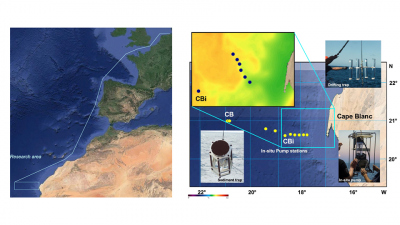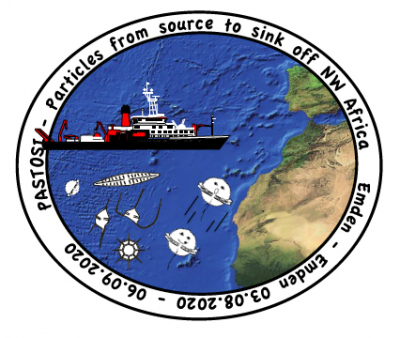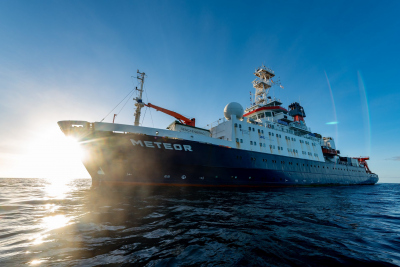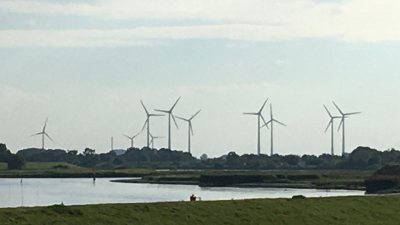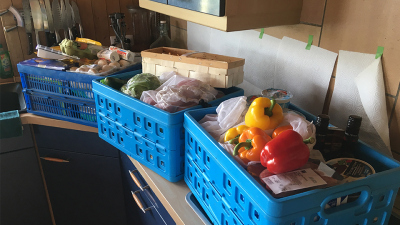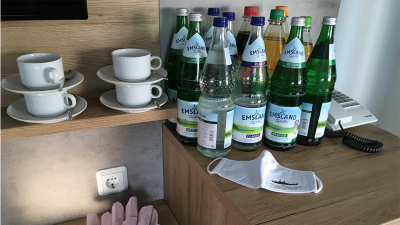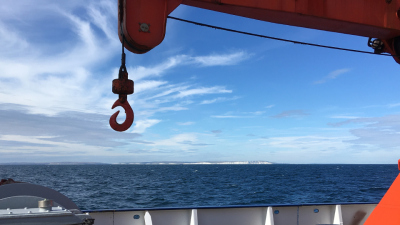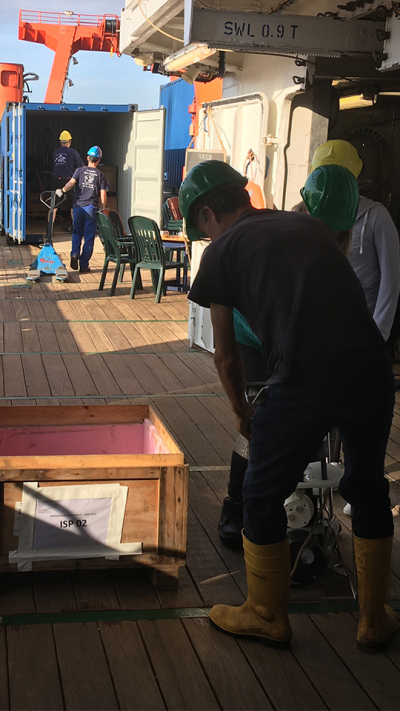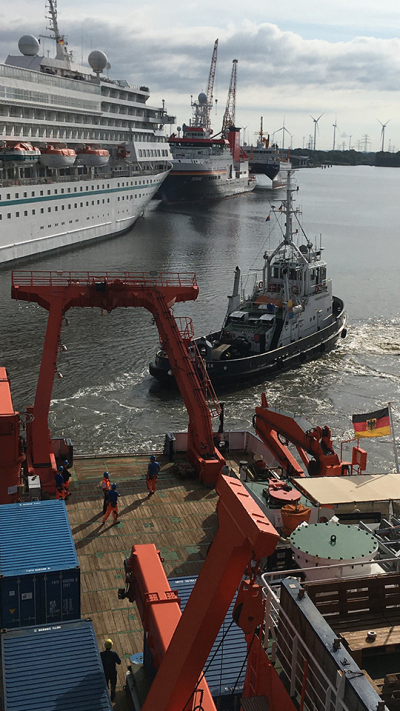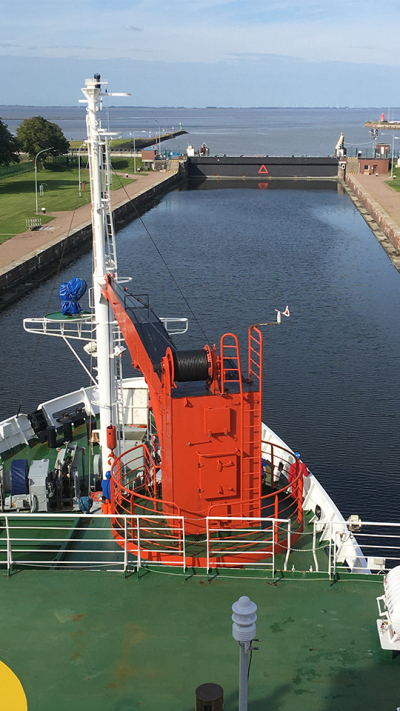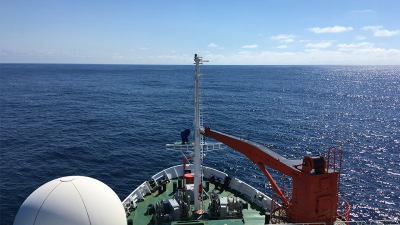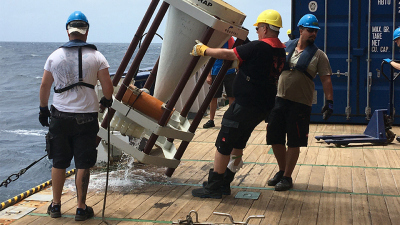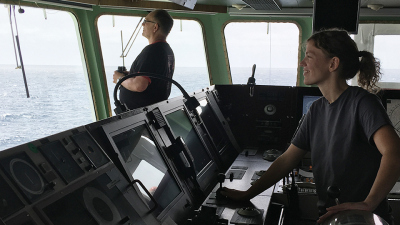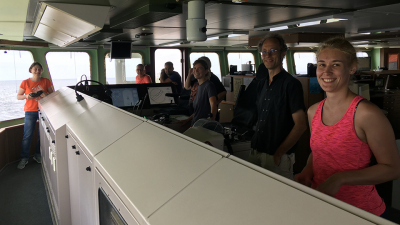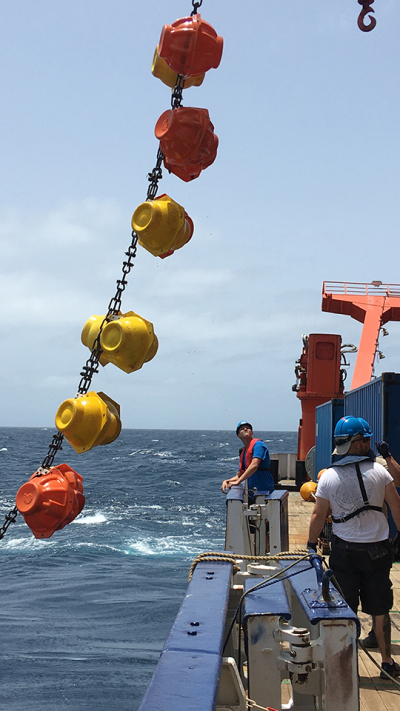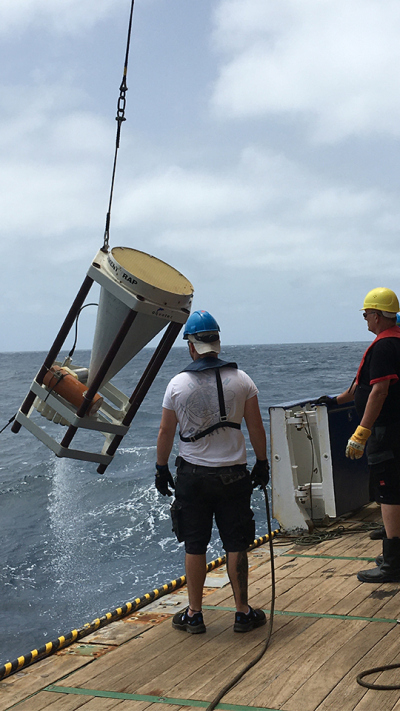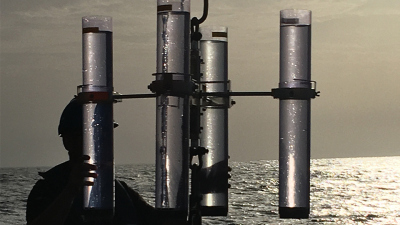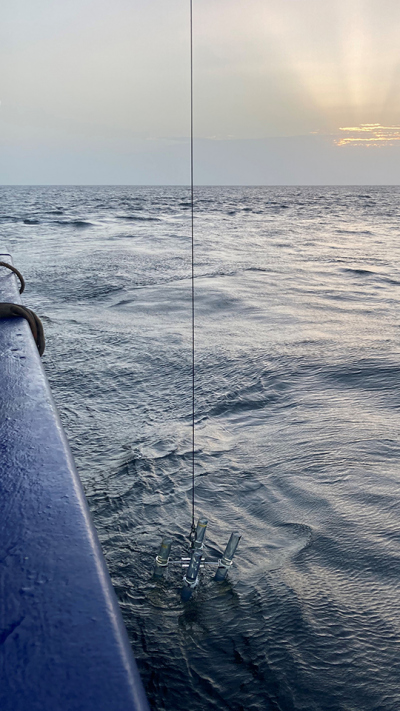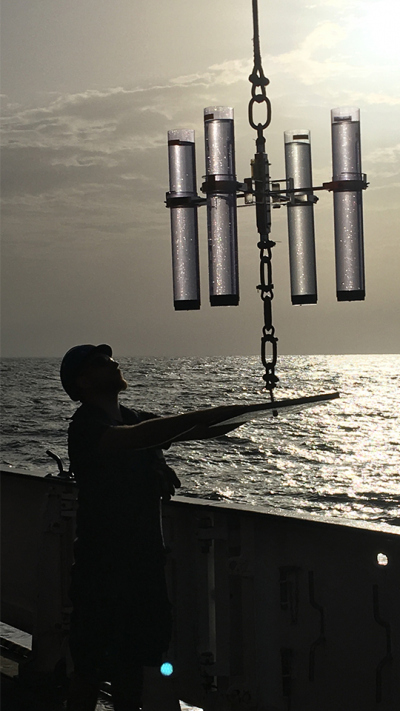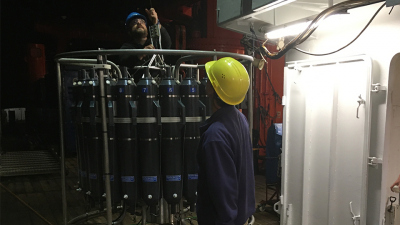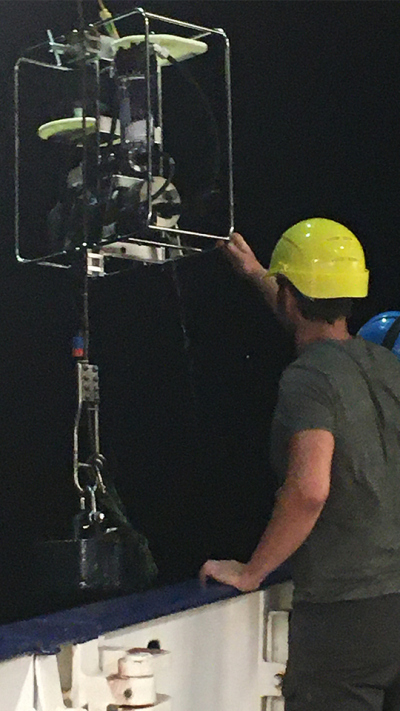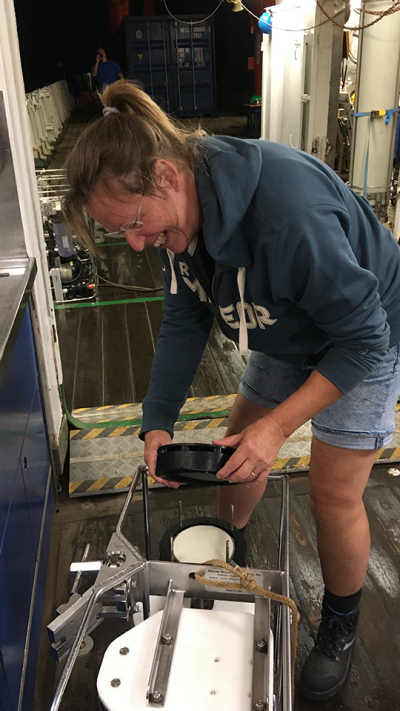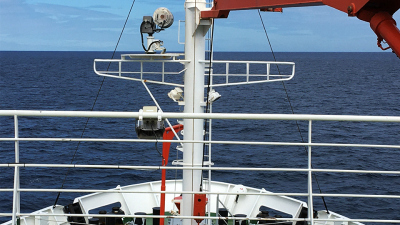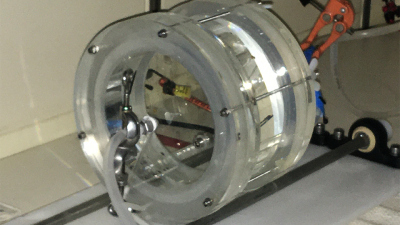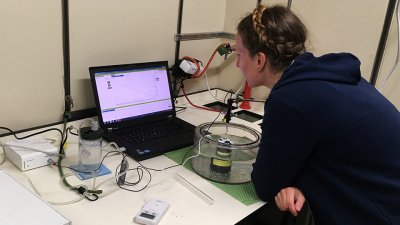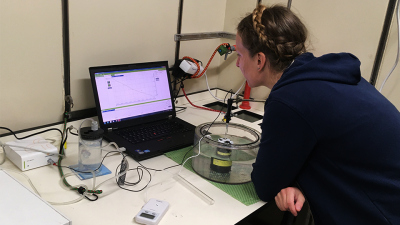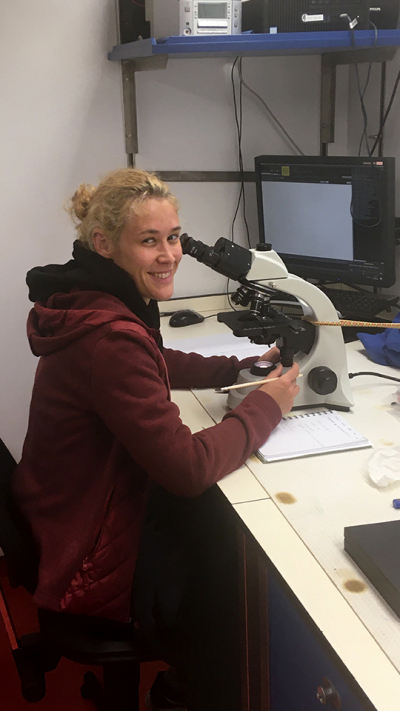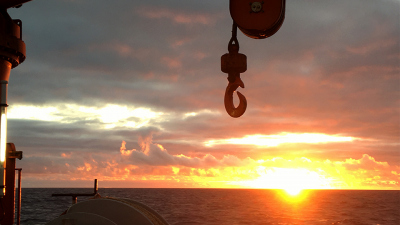- Home
- Discover
- Ship's logs
- Ship's log METEOR 165 (GPF 18-1_81)
Ship's log METEOR 165 (GPF 18-1_81)
The research expedition M 165 (GPF 18-1_81) will take place from 03 August to 06 September 2020 and will lead off the west coast of Africa, into the upwelling zone at Cap Blanc.
During this cruise the first part of the research activities of the scientific programme "PASTOSI" (PArticles from Source TO SInk off northwest Africa) will be carried out. On board the research vessel METEOR are a total of 15 researchers from MARUM, the Department of Earth Sciences of the University of Bremen, the Alfred Wegener Institute, the ICBM and the German Weather Service.
Together they will find out more about the factors influencing the vertical particle flow of organic material and (bio-) minerals in the water column and surface sediment. To date, very little is known about the production, vertical and lateral transport of particles and their transformation, and the influence of these aspects on selected environmental proxy signals in marine archives.
Thursday, July 30th 2020: Expedition M165, here we go!
After two weeks of "home quarantine" we have now arrived at the Ostfriesenhof in Leer where we will not leave our room for the next four days. We, that are 15 students, PhD students, postdocs, technicians and PI's from the MARUM-University Bremen, AWI-Bremerhaven and the University Oldenburg. All of us will be tested on Corona tomorrow to make sure that we do not carry the virus in our luggage on board the RV. Meteor.
But although locked up... my room is spacious and pleasantly furnished, has a balcony, view on the river Ems... I am well supplied with drinks, the food is delicious and there is internet with a lot of bandwidth :-)
The expedition M165 should have taken place in April, but the worldwide outbreak of the Corona virus came in between. Because of the excellent cooperation and flexibility of the employees of the “Portal Deutsche Forschungsschiffe (Deutsche Forschungsgemeinschaft DFG), die Leitstelle Deutsche Forschungsschiffe at the University Hamburg and Briese Research Forschungsschiffahrt, a possibility was created to continue our marine research at sea.
During the expedition, a long-term research project of MARUM/University of Bremen will be continued. Since 1988, this project has been exploring how the ocean off NW Africa reacts to today's climate and environmental change. More details about that will follow soon but can also be found at https://www.marum.de/Karin-Zonneveld/R.V.-meteor-reise-m165-pastosi-part-1.html
Text and pictures by Karin Zonneveld.
Tuesday, August 4th: On our way south
Yes, we are on our way south :-).
Two days ago, we were released from our quarantine-hotel rooms and we transported covid19-safe by bus to the R.V. Meteor.
Upon arrival on the ship, after the warm welcome by captain and ship-crew, we started immediately to unpacked our research equipment. This equipment, needed for scientific sampling and analyzing of the samples and the ocean environment, was packed in boxes in the weeks previous to the cruise to be transported to the ship in containers. We now moved these boxes to the laboratories and unpacked and installed equipment as much as possible. Reason for this immediate action was that it is much safer to move equipment when the ship is laying quietly in harbor than when it is sailing and experiences wave movement... and we were expected the leave port of Emden already early the next morning.
Once unpacked and installed in the laboratories, all equipment like computers, microscopes and analytical equipment has to be secured with lash belts to the ship to prevent it from topping over, falling down or moving. Small items such as laptops are place on anti-slipping foul to prevent it sliding tables in case of rough weather.
Yesterday morning 9 o’clock the cables were released and a tugboat towed us out of the harbour into the floodgate that connects the Harbor of Emden with the Waddensea. After entering the North Sea, the day was filled with further unpacking and installing equipment, finding the way on the ship, the first safety drilling, technical and scientific briefings.
Today we crossed the English Channel with beautiful weather, blue sea, blue sky and the white cliffs of Dover and say goody to the North Sea. For the next days we will be hiding steadily south crossing the Gulf of Biscaya, the North Atlantic Ocean off Spain, passing the Canary Islands to reach the “upwelling region” off Cape Blanc.
Text and pictures by Karin Zonneveld.
Thursday, August 6th: Hello Ocean!
After a slow journey through the English Channel we have now entered the open Atlantic Ocean. Here, the water is more than four thousand meters deep instead of barely scratching a hundred. There is nothing between us and North America to break the wind or the waves.
You can see and feel the difference – no more wind parks in the distance, barely any other ships, the whole ship is swinging left and right, forward and backward, and during meals the mess is a little emptier than on previous days. During the first days, everyone was planning, studying, preparing and sometimes even playing Ping Pong in the evening hours, but now the science crew is taking it a little slower. For the ship crew, it’s just business as usual.
Text and pictures by Elinor Tessin
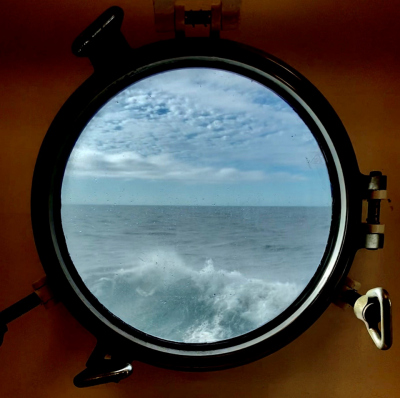
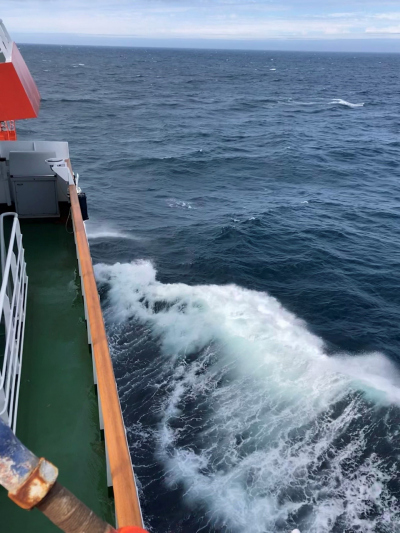
Monday, August 10th: Baleens and balloons
Since the weather calmed down on Thursday, we have been spending more and more time on deck, and as it turns out, the ocean is just teeming with life out here. We spotted our first dolphin in the deep blue Bay of Biscay, and now we keep seeing them all over the place. Most of them turn out to be a mixture of waves and our overactive imagination, but we also saw two whales, or at least the spray they discharge while breathing at the surface. I took some pictures, but won’t bother sending them to Germany because you can easily imagine them for yourself: a lot of blue, and then a tiny blur of white somewhere off in the distance.
A dolphin joined the research vessel for a while.
Yesterday we were a little luckier and spotted a dolphin checking out the ship from up close.
The balloon is released through the hatch, the sensor is hanging below.
While our own scientific sampling has to wait for when we reach Cape Blanc, probably on Wednesday, there is already plenty to measure for ship meteorologist Frank. For example, by sending out weather balloons. After inflating them with helium and attaching a sensor to measure air pressure and temperature, they are released into the sky. They rise quickly, thousands of meters within just a few minutes, but you can still spot them a long way off: as they reach thinner air, the helium inside the balloon expands to match it, and the balloon grows from just about a meter to up to six meters in diameter.
The sensor sends continuously measurements back to the ship during where they are being analyzed. After about an hour, the processed information is sent out internationally. The results are especially important for aviation.
A few moments later it has already risen hundreds of meters.
Text and videos by Elinor Ticino, photos by Karin Zonneveld.
Wednesday, August 12th: Sediment traps
We're here,
Yesterday at half past one local time we finally arrived at our destination; station GeoB 24101. Since 1988, the MARUM collects particles that sink down through the water column on this location.
How? We collect these particles with sediment traps.
On this position the sediment traps consist of two big funnels which are attached to a wire above each other. Below the funnels collecting beakers connected, that have been programmed to be replaced every two weeks. These beakers have collected material from November 2018 to March 2020. Actually, they should have been replaced already in March this year, but unfortunately Corona came in between… :-) but as explained already some days ago, were are very lucky that we get the opportunity to be here with the RV Meteor.
The wire to which the funnels are attached is attached to an anchor which is located on the sea floor at a depth of almost 4200 meters. The wire is held in a horizontal position by floats attached to the other end. Between the wire and the anchor there is a so-called "releaser"; a fixture that loosens when targeted at a certain sound frequency.
At noon quarter to 1 it was time. The ship was in position and the sound frequency was released under water. Now the exciting waiting began. When the trigger has released the mooring, it takes 15 to 20 minutes until the first bright yellow and orange floats come to the water surface.
Shortly after 1 p.m. the words of salvation were heard.... "I see them!"
Then followed the catching of the floats, the hauling in of the wire and the recovery of the sediment traps.
At 16 o'clock both traps were securely fastened to the deck and the investigations of the collected material could begin.
Text and pictures by Karin Zonneveld.
Monday, Auguts 24th: Drifting traps
This patch of ocean is particularly full of life because it is constantly restocked with nutrients: as currents push water away from the coast, deep water flows upwards. This is called upwelling. The nutrients in that deep water in combination with sunlight make an ideal habitat for microalgae.
This is where the microscopic feeding frenzy begins. Microalgae growth explodes, other microorganisms feed on them, and provide food for larger creatures in turn. Dead and dormant cells, zooplankton excrements, and all kinds of other debris sink down from these communities towards the bottom of the sea.
A few days ago, we set out a drifting trap to follow one such upwelling cell. The trap is made up of long tubes containing brine water fixed onto a rope, kept upright by floats. The brine water inside the tubes is much saltier, and therefore heavier, than the seawater around it. That means that everything sinking into the tubes will stay in there until we collect it. The tubes are fixed along the rope at different depths, between 100 and 450 meters, so that we can compare how far different kinds of particles sink. A locating beacon tells us where the trap moves as it drifts away with the upwelling cell, while we continue with the rest of our research program. Every morning, we catch up with the trap, empty the tubes, refill them with brine water and set the trap adrift again.
We find many different kinds of lifeforms and particles in the traps. To study microalgae, we filter our samples to keep only particles between 20 and 100 micrometers in size. Usually, you can’t see those without a microscope, but the color of the water gives them away. Before filtering, the water is greenish, and afterwards, almost entirely clear.
The upwelling cell that we chose eventually turned towards the coast, so we picked a new spot to release our trap this morning. Upwelling cells are easily visible in satellite images that depict the temperature of the ocean surface: wherever the ocean is cooler than its surroundings, upwelling is in progress.
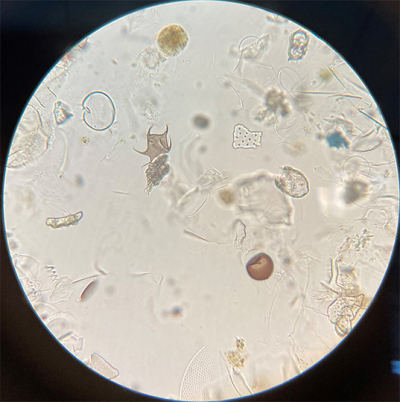
Text by Elinor Tessin. If not stated otherwise, photos by Elinor Tessin.
Monday, August 31st: Nightshift
Night work: Particles from 4000m waterdepth and dolphins
In the twilight of this early morning the twinkling lights on the Island Madeira greeted us at the horizon. We are on our way home but it will take another 9 days before we will enter the port in Emden. The last days of “station work” as we call the sampling period in the research area, were very intensive and, as is usual on a marine expedition, we worked during the days and nights min different shifts.
During the day equipment is used that needs daylight to deploy. For instance because the equipment is heavy and needs special stabilisation with wires on the moving ship or has to be spotted between the waves on the blue ocean surface such as the drifting traps and moorings. During the night lighter equipment can be deployed such as for instance the CTD/Rosette and In-situ pumps.
With a CTD/Rosette we characterise the water column and sample water at the same time. CTD stands for “Conductivity, Temperature, Density” and together with extra added sensors we can measure the temperature, salinity, oxygen, living plankton (chlorophyll-a) and amount of particles that float in the water (= turbidity). This equipment is placed on a wire with an electricity cable inside that we led slowly sink down through the water column, in our case to a maximal 4200 m deep waters. On a computer we can see online how the temperaturee, salinty, oxygen, chlor-a and turbidity changes. On the way up we can give an order to close the water bottles of the Rosette with the same computer.
In-situ pumps are sort of “under water vacuum cleaners”. They are also connected on a wire that leds them down to those water depths where there are a lot of particles, based on the CTD information we got earlyer. These vacuum cleaners suck in water and filter particles at the same time. Apart from particles produced by plankton we also look for micro-plastic during this cruise. For this we developed a sampling procedure that minimizes the risk of contamination during sampling, e.g. by avoiding the wearing of plastic derived clothing (e.g. fleece jackets) and minimizing air-exposure during harvesting of samples.
During the night deployments, large beams of light from the ship are directed to the place where the CTD/Rosette and In-situ pumps are being deployed. This provides a beautiful tranquil and fascinating atmosphere. The light on the water gives it a turquoise blue colour. The lights attracts all sorts of plankton which in turn attracts small fish that in turn attract calamares.
Our very last station was very special. Hundreds of Calameres came to the surface to catch the flying fish that jumped out of the water to spread their fins that enable them to “fly” sometime 10ths of meters before they fall into the ocean again. After a while, suddenly a hammerhead shark appeared followed somewhat later by more than 50 dolfins. The dolphins treated us with a real show. They collectively hunted in rows of about 10 animals next to each other. They jumped out of the water and dived synchronously. When they reached the other side of the ships lightbeam, they reorganised and synchronously started the next attack on the numerous calemares that had gathered near the ship.
Unfortunately every “show” has an end and when the last in-situ pump came on deck in the early morning hours we had to turn off the lights to leave for our long transit home. After collecting and processing the samples we went to bed for a few hours of sleep with a smile on our face and the beautiful night scenes still before our now closed eyes.
Text by Karin Zonneveld. If not stated otherwise, photos by Karin Zonneveld.
Friday, September 4th: Last experiments and almost home
Almost at home,
Today we sail through the English Channel, together with numerous other ships that nicely sail behind each other on the “ship’s highway”. Here separate sailing lanes divide the traffic that enters and leaves the English channel. Although the name says “Englisch Channel”, the ships do not follow the English characteristic driving direction but follow that from the “continent” on the right side of the lane.
Our long transit home almost comes to an end and we expect to enter Port on Sunday morning. After the intensive sampling period last week there was not much time to relax. The transit time was intensively used to perform experiments and analyse our the freshly sampled samples.
For instance, we investigate if and how the small particles that are being formed in the upper water column clump together and form so called aggregates. Furthermore it is investigated how the biological, physical and chemical interaction between aggregates and dissolved organic substances in the water functions as well as how old the aggregates are that we have collected direct out of different water masses.
We need this information to better understand how the current enormous increase in atmospheric CO2 (this year the atmospheric CO2 concentration increase is extreme because of the large fires in Siberia and Brazil) as well as our increasing pollution (e.g. by microplastic) influences our global climate and environment.
Namely, these particles and aggregate are formed of remains of marine organisms (plankton but also remains of bacteria and archaea) but also of pollutants such as microplastics. Plankton contains carbon that previously is diffused as CO2 out of the atmosphere into the ocean water and is being transformed by photosynthetic organisms into biomass. If the marine particles and aggregates sink thought the water column and settle on the ocean floor they transport carbon from the atmosphere to the ocean floor. This process is called “the ocean carbon pump” and it removes in a natural way CO2 from the atmosphere to be stored in the ocean floor. The same happens with microplastics. These particles also settle on the ocean floor where they might be preserved and will form a pollutant “heritage” for future generations.
If we know which particles clump to each other to aggregates, how these aggerates sink, for instance do they fall down directly or do they float and remain in the water column for years before they settle, we will better understand the ocean carbon pump. If we know how long micro plastic remains in the water column, how it sinks (vertically or is it also transported laterally before it settles) where it settles and which plastic types are being degraded e.g. by microorganisms and which particles will preserve and will be permanently be stored in the ocean floor, we can better estimate the environmental footprint we leave on the ocean floor.
For me personally I severely hope that we will find some microplastic types that can be degraded on a natural way by microorganisms that live in the ocean floor sediments. If we find this that would be fantastic as it than might open a way to replace the many not degradable plastic types with these materials. This in turn could than reduce the world-wide pollution. But... we first have to analyze our sampled material in the coming months to see if my dreams come true...
Today we will finish our last experiments and analyses on board of the METEOR to be continued in our home laboratories. We will store our equipment safely in transport boxes where they will be brought back to the institutes on Monday when we embark the ship.
We are very glad that we have become the opportunity to sail with this great research ship so far south to continue our research. My severe thanks to everybody that have made this possible.
Text and pictures by Karin Zonneveld.



